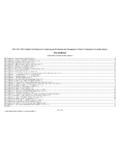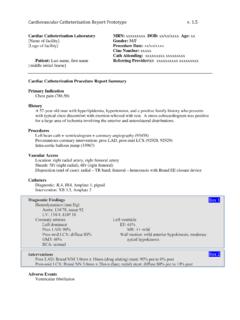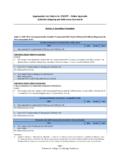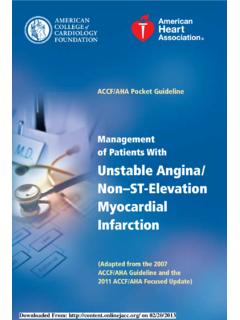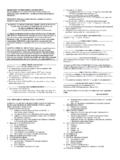Transcription of 2014 AHA/ACC/HRS Atrial Fibrillation Guideline Data ...
1 American College of Cardiology Foundation and American Heart Association, Inc. 1 2014 AHA/ACC/HRS Atrial Fibrillation Guideline Data Supplements (Section numbers correspond to the full-text Guideline .) Table of Contents Data Supplement 1. Electrophysiologic Mechanisms in the Initiation and Maintenance of AF (Section 2) .. 2 Data Supplement 2. Pathophysiologic Mechanisms Generating the AF Substrate (Section 2) .. 2 Data Supplement 3. oral Anticoagulants (Dabigatran, Rivaroxaban, Apixaban) vs. Warfarin (Section ) .. 3 Data Supplement 4. Warfarin vs. Control (Section ) .. 6 Data Supplement 5. Warfarin vs. Antiplatelet Therapy (Section ) .. 7 Data Supplement 6. Beta Blockers (Sections ) .. 9 Data Supplement 7. Nondihydropyridine Calcium Channel Blockers (Sections ) .. 10 Data Supplement 8. Digoxin (Sections ) .. 11 Data Supplement 9. Other Pharmacological Agents for Rate Control (Sections ) .. 12 Data Supplement 10. AV Junction Ablation (Sections ) .. 13 Data Supplement 11.
2 Broad Considerations in Rate Control (Sections ) .. 13 Data Supplement 12. Antiarrhythmic Drug Therapy (Section ) .. 14 Data Supplement 13. Outpatient Initiation of Antiarrhythmic Drug Therapy (Section ) .. 24 Data Supplement 14. Upsteam Therapy (Section ) .. 25 Data Supplement 15. AF Catheter Ablation to Maintain Sinus Rhythm (Section ) .. 27 Data Supplement 16. Meta-Analyses and Surveys of AF Catheter Ablation (Section ) .. 30 Data Supplement 17. Specific Patient Groups (Section 7) .. 31 References .. 37 American College of Cardiology Foundation and American Heart Association, Inc. 2 Data Supplement 1. Electrophysiologic Mechanisms in the Initiation and Maintenance of AF (Section 2) Mechanism References Experimental Human Multiple wavelet hypothesis (1-3) (4-8) Heterogeneity in Atrial electrophysiology (3, 9) (10-13) Focal firing (14-17) (18-21) Pulmonary vein foci o Electrophysiology (16, 22-28) (29, 30) o Evidence for reentry (24, 31-33) (30, 34-36) o Evidence for focal firing (32) (35) Nonpulmonary vein foci (17) (19, 21, 37-42) Rotor with fibrillatory conduction (9, 31-33, 43-46) (34-36, 47-50) Dominant frequency gradients (9, 32, 43, 46, 51) (34, 49-52) AF indicates Atrial Fibrillation .
3 Data Supplement 2. Pathophysiologic Mechanisms Generating the AF Substrate (Section 2) Mechanism References Experimental Human Atrial structural abnormalities (9, 53-55) (56-62) Fibrosis (63-70) (55, 56, 62, 63, 71-73) Noninvasive imaging of fibrosis (74, 75) (76-79) Inflammation/oxidative stress (80-83) (59, 80, 82-88) Steroids (89-91) N/A Statins (92-94) N/A Omega-3 polyunsaturated fatty acids (95-100) (96, 101-103) Renin-angiotensin-aldosterone system activation (104-114) (72, 115, 116) Aldosterone (117, 118) (119-121) Transforming growth factor- 1 (68, 122, 123) N/A Autonomic nervous system (3, 14-16, 27, 124-126) (127-129) Genetic variants See Section Atrial tachycardia remodeling Electrophysiologic (9, 130-136) (137, 138) Structural (53, 132, 139-142) N/A Intracellular calcium (143-145) (145-148) Extracardiac factors See Section AF indicates Atrial Fibrillation . American College of Cardiology Foundation and American Heart Association, Inc. 3 Data Supplement 3.
4 oral Anticoagulants (Dabigatran, Rivaroxaban, Apixaban) vs. Warfarin (Section ) Study Name, Author, Year Study Aim Study Type/Size (N) Intervention vs. Comparator (n) Patient Population Study Intervention Endpoints P Values, OR: HR: RR: & 95% CI: Adverse Events Study Limitations Inclusion Criteria Exclusion Criteria Primary Endpoint & Results Safety Endpoint & Results Secondary Endpoint & Results RE-LY Randomized Connolly SJ, et al., 2009 (149) 19717844 To compare 2 fixed doses of dabigatran with open-label use of warfarin in pts with AF at increased risk of stroke RCT, open-label, blinded doses of dabigatran (18,113) Dabigatran 110 mg (6,015) Dabigatran 150 mg (6,076) Warfarin (6,021) AF and 1 of the following: prior stroke or TIA; LVEF<40%, NYHA class II or higher HF Sx, age 75 y or an age of 65-74 y plus DM, HTN, or CAD Mean CHADS2 of Severe heart-valve disorder, stroke within 14 d or severe stroke within 6 mo, condition that increased hemorrhage risk, CrCl <20 mL/min, active liver disease, pregnancy Dabigatran in 2 fixed doses oral prodrug, direct competitive inhibitor of thrombin Warfarin INR 2-3, mean TTR 64% Stroke or SE Dabigatran110 mg Dabigatran 150 mg Warfarin Major Hemorrhage Dabigatran 110 mg Dabigatran 150 mg Warfarin Intracranial Bleeding Dabigatran 110 mg Dabigatran 150 mg Warfarin Major GI Stroke Dabigatran 110 mg Dabigatran 150 mg Warfarin Stroke, ST elevation, PE, MI, death, or major bleeding Dabigatran 110 mg Dabigatran 150 mg Warfarin Dabigatran 110 mg RR: ; 95% CI: ; p< for noninferiority, p= for superiority Dabigatran 150 mg RR: ; 95% CI.
5 P< for noninferiority, p< for superiority Dyspepsia Open-label Median duration of FU 2 y American College of Cardiology Foundation and American Heart Association, Inc. 4 Dabigatran 110 mg Dabigatran 150 mg Warfarin ROCKET-AF Patel MR, et al., 2011 (150) 21830957 To compare QD oral rivaroxaban with dose-adjusted warfarin for the prevention of stroke and SE in pts with NVAF who were at moderate to high risk of stroke RCT, double-dummy, double-blinded (14,264) Rivaroxaban (7,131) Warfarin (7,133) NVAF at moderate to high risk of stroke: Hx of stroke, TIA, or SE or 2 of the following (HF or LVEF<35%, HTN, age >75 y, DM (CHADS2 score of 2) Mean CHADS2 score of Severe valvular disease, transient AF caused by a reversible disorder, hemorrhage risk related criteria; severe, disabling stroke within 3 mo or any stroke within 14 d, TIA within 3 d; indication for anticoagulant Tx Rivaroxaban Factor Xa inhibitor, 20 mg QD or 15 mg QD for those with CrCl of 39-40 mL/min Warfarin INR 2-3, mean TTR 55% Any stroke or SE Per-protocol as treated Rivaroxaban Warfarin Intention to Treat Rivaroxaban Warfarin Major and non-major clinically relevant bleeding Rivaroxaban pt-years Warfarin pt-years ICH Rivaroxaban pt-years Warfarin pt-years Major GI Rivaroxaban Warfarin Stroke, SE, or VD Rivaroxaban pt-years Warfarin pt-years HR: ; 95% CI: ; p= Per-Protocol, as treated HR: ; 95% CI: ; p< for noninferiority Intention to treat HR: ; 95% CI: ; p< for noninferiority p= for superiority N/A Median duration of follow-up was 707 d Lower TTR in warfarin group 1 analysis was prespecified as a per-protocol analysis High-event rate after discontinuation of Tx American College of Cardiology Foundation and American Heart Association, Inc.)
6 5 ARISTOTLE Granger CB, et al., 2011 (151) 21870978 To determine whether apixaban was noninferior to warfarin in reducing the rate of stroke (ischemic or hemorrhagic) or SE among pts with AF and 1 other risk factor for stroke RCT, double-dummy, double-blinded (18,201) Apixaban (9,120) Warfarin (9,081) AF and 1 stroke risk factor (age >75 y; previous stroke, TIA or SE; symptomatic HF within the prior 3 mo or LVEF 40%; DM; or HTN) Mean CHADS2 score of AF due to a reversible cause, moderate or severe mitral stenosis, conditions other than AF requiring OAC, stroke within the prior 7 d, a need for ASA>165 mg or for ASA and CP, or severe renal insufficiency (CrCl<25 mL/min) Apixaban Factor Xa inhibitor 5 mg BID or mg BID among pts with 2 of the following ( 80 y, body weight 60 kg, or serum Cr level of mg/dL) Warfarin INR 2-3 Mean TTR Any stroke or SE Apixaban Warfarin Major Bleeding Apixaban Warfarin ICH Apixaban Warfarin Major GI Apixaban Warfarin Stroke, SE, major bleeding, or death from any cause Apixaban Warfarin HR: ; 95% CI: ; p< for noninferiority, p= for superiority HR: ; 95% CI: ; p< No differences Median duration of FU y AVERROES Connolly SJ, et al.
7 , 2011 (152) 21309657 To determine the efficacy and safety of apixaban, at a dose of 5 mg BID, as compared with ASA, at a dose of 81-324 mg QD, for the Tx of pts with AF for whom VKA Tx was considered unsuitable RCT double-blind, double-dummy (5,559) Apixaban (2,808) ASA (2,791) 50 y and AF and 1 of the following stroke risk factors: prior stroke or TIA, 75 y, HTN, DM, HF, LVEF 35%, or PAD. Pts could not be receiving VKAs Pts required long-term anticoagulation, VD requiring surgery, a serious bleeding event in the previous 6 mo or a high-risk bleeding, stroke Apixaban Factor Xa inhibitor 5 mg BID or mg BID among pts with 2 of the following (age 80 y, body weight 60 kg, or serum Cr level of mg/dL) ASA Any stroke or SE Apixaban ASA p< Major Bleeding Apixaban ASA Intracranial Bleeding Apixaban ASA Major GI Stroke, SE, MI, VD or major bleeding event Apixaban ASA HR: ; 95% CI: ; p< HR: ; 95% CI: ; p< No differences N/A American College of Cardiology Foundation and American Heart Association, Inc.
8 6 because it had already been demonstrated to be unsuitable or because it was expected to be unsuitable. Mean CHADS2 of within the previous 10 d, severe renal insufficiency (a sCr> mg/dL) or a calculated CrCl<25 mL/min 81-325 mg/dL Apixaban ASA 1 indicates primary; AF, Atrial Fibrillation ; ARISTOTLE, Apixaban for Reduction in Stroke and Other Thromboembolic Events in AF; ASA, aspirin; AVERROES, Apixaban Versus Acetylsalicylic Acid to Prevent Stroke in Atrial Fibrillation Patients Who Have Failed or Are Unsuitable for Vitamin K Antagonist Treatment; BID, twice daily; CAD, coronary artery disease; CHADS2, Congestive heart failure, Hypertension, Age 75 years, Diabetes mellitus, Stroke; ; CP, codeine phosphate; Cr, creatinine; CrCl, creatinine clearance; DM, diabetes mellitus; FU, follow-up; GI, gastrointestinal; HF, heart failure; HR, hazard ratio; HTN, hypertension; Hx, history; ICH, intracranial hemorrhage; INR, international normalized ratio; LVEF, left ventricular ejection fraction; MI, myocardial infarction; N/A, not applicable; PAD, peripheral arterial disease.
9 PE, pulmonary embolism; N/A, not applicable; NVAF, nonvalvular Atrial Fibrillation ; NYHA, New York Heart Association; OAC, oral anticoagulation; pts, patient; QD, once daily; RCT, randomized controlled trial; RE-LY, Randomized Evaluation of Long-Term Anticoagulation Therapy; ROCKET-AF, Rivaroxaban Once Daily oral Direct Factor Xa Inhibitor Compared with Vitamin K Antagonism for Prevention of Stroke and Embolism Trial; RR, relative risk; sCr, serum creatinine; SE, systemic embolism; Sx, symptom; TIA, transient ischemic attack; TTR, time in therapeutic range; Tx, therapy; VD, valvular disease; and VKA, vitamin K antagonist. Data Supplement 4. Warfarin vs. Control (Section ) Study Name, Author, Year Study Aim Study Type/ Size (N) Intervention vs. Comparator (n) Patient Population Study Intervention Endpoints P Values, OR: HR: RR: & 95% CI: Inclusion Criteria Exclusion Criteria Primary Endpoint & Results Safety Endpoint & Results Secondary Endpoint & Results Aguilar MI, et al., 2005 (153) 16034869 To characterize the efficacy and safety of oral anticoagulants for the 1 prevention of stroke in pts with chronic AF Cochrane Collaboration Systematic Review (AFASAK I, BAATAF, CAFA, SPAF I, SPINAF) 2,313 pts Warfarin 1,154 PC 1,159 AF (intermittent or sustained) Prior stroke or TIA, mitral stenosis or prosthetic cardiac valves oral VKAs (warfarin) mean INR All Stroke (ischemic or ICH) Warfarin 27 PC 71 ICH, Major extracranial bleeds ICH, Warfarin 5, PC 2 Extracranial bleeds, Warfarin Stroke, MI or VD Warfarin 69 PC 118 All ischemic stroke or ICH OR: ; 95% CI: Ischemic stroke OR: ; 95% CI: American College of Cardiology Foundation and American Heart Association, Inc.
10 7 17, PC 16 Stroke, MI, VD OR: ; 95% CI: All ICH OR: ; 95% CI: ) Major extracranial bleeds OR: ; 95% CI: 1 indicates primary; AF, Atrial Fibrillation ; AFASAK, Atrial Fibrillation , Aspirin and anticoagulant Therapy Study; BAATAF, Boston Area Anticoagulation Trial for Atrial Fibrillation ; CAFA, Canadian Atrial Fibrillation Anticoagulation ; ICH, intracranial hemorrhage; INR, international normalized ratio; MI, myocardial infarction; N/A, not applicable; OR, odds ratio; PC, placebo; Pts, patients; RR, relative risk; SPAF I, Stroke Prevention in Atrial Fibrillation Study; SPINAF, Stroke Prevention in Atrial Fibrillation ; TIA, transient ischemic attack; VD, vascular death; and VKA, vitamin K antagonist. Data Supplement 5. Warfarin vs. Antiplatelet Therapy (Section ) Study Name, Author, Year Study Aim Study Type/ Size (N) Intervention vs. Comparator (n) Patient Population Study Intervention Endpoints P Values, OR: HR: RR: & 95% CI: Study Limitations Inclusion Criteria Exclusion Criteria Primary Endpoint & Results Safety Endpoint & Results Secondary Endpoint & Results Aguilar MI, et al.
